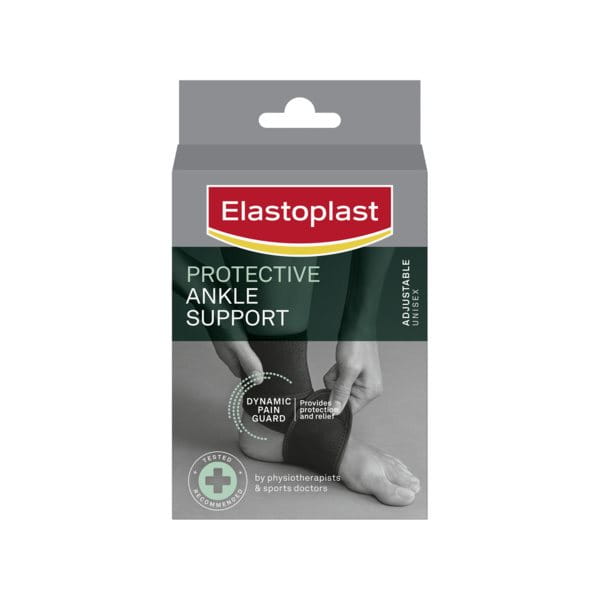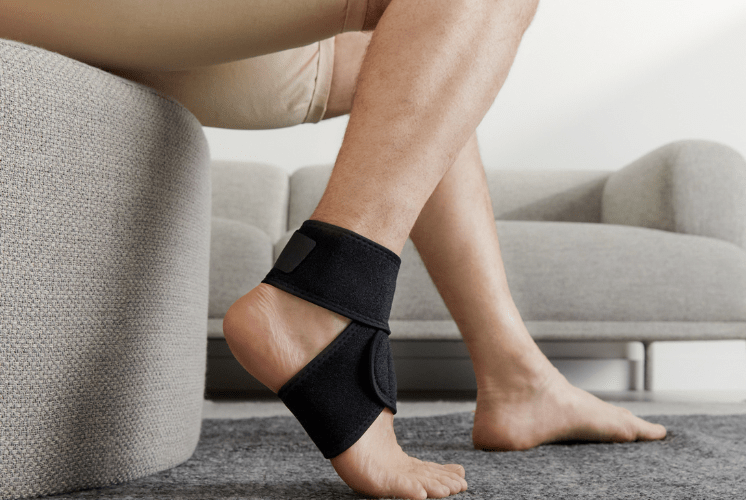A sprained ankle can be a common yet debilitating injury that can significantly hinder your daily activities. It is usually caused by the ankle suddenly twisting or rolling (an inversion sprain). This damages the ligaments that support the ankle, as they become overstretched and may even tear.
Whether you sprained your ankle during sports, exercise, or a simple misstep, proper recovery is crucial for a swift return to normal functioning. By following the appropriate steps outlined in this article, you can accelerate the healing process and regain strength and stability in your ankle.
How to tell if your ankle is sprained

Although very painful, you can heal from an ankle sprain if the proper precautions are taken. To find out whether you have a sprained ankle you can check for these common symptoms:
- Pain: You may experience pain in the affected ankle, especially when you try to put weight on it or move it.
- Swelling: Ankle sprains often result in swelling around the injured area. The swelling may occur immediately after the injury or develop over time.
- Bruising: You might notice bruising or discoloration around the ankle.
- Limited range of motion: Spraining an ankle can cause stiffness and limited movement in the joint.
- Instability: You may feel that your ankle is unstable, or gives way when you try to walk or stand.
It can initially be hard to tell the difference between a sprained ankle vs a broken ankle. Many of the symptoms such as pain, swelling and bruising, are both caused by twisting or rotating the ankle beyond its limits. However a break is categorised as damage to the bone and is considered more serious than a sprain, taking considerably longer to heal.
Severity of ankle sprains and the healing time
Ankle sprains are typically categorised into different grades based on the severity of the injury.
The severity of sprains is usually categorised in groups which highlight the extent of the damage to the ankle and the corresponding recovery time.
- Grade 1: This is the mildest form of ankle sprain. It involves stretching or slight tearing of the ligaments without significant instability. Symptoms may include mild pain, minimal swelling, and minimal or no bruising. These types of sprained ankle can take around 3 to 5 weeks to heal.
- Grade 2: A grade 2 sprain is a moderate injury. It involves partial tearing of the ligaments and results in more noticeable symptoms. Pain, swelling, and bruising are generally more pronounced, and walking or bearing weight on the ankle can be challenging. These forms of injuries may take 4 to 6 weeks to heal.
- Grade 3: Grade 3 sprains are the most serious and involve a complete tear or rupture of the ligaments. This type of sprain has the same features as the previous grades but is much more severe. The ankle may feel unstable, and there might be a visible deformity. It can take between 3 to 6 months to make a full recovery.
How long does a sprained ankle stay swollen?
The duration of swelling from an ankle sprain can vary depending on the severity of the injury. During the initial 48 to 72 hours after the sprain, the swelling typically peaks and may be at its most noticeable. After this acute phase, the swelling gradually subsides over time as the healing process progresses.
Sprained ankle treatment
There are several processes to take to fully recover from a sprained ankle and there are steps to start the healing process yourself. However, it is always best to get an official diagnosis from a doctor or physiotherapist and a subsequent treatment plan.
RICE and pain management
After an ankle sprain it is important to start the healing process right away. If the injury is especially painful consider taking painkillers such as ibuprofen which can alleviate pain and reduce inflammation. Be sure to follow the recommended dosage.
Rest:
Immediately after spraining your ankle, it is crucial to rest and avoid putting weight on the injured foot. Continuing to walk or engage in physical activities can worsen the injury and delay the healing process. Use crutches, a walking aid, or consider limiting weight-bearing activities until the pain subsides.
Ice:
Applying ice to the affected area helps reduce swelling, pain, and inflammation. Use an ice pack wrapped in a thin towel or cloth to protect your skin from direct contact with the ice. Apply the ice pack to the sprained ankle for 15-20 minutes at a time, every 2-3 hours during the first 48-72 hours after the injury. Remember not to apply ice directly to your skin to avoid ice burns.
Compression:
Compression is achieved by wrapping the injured ankle with a compression bandage or using an elastic ankle wrap. Compression helps reduce swelling by applying gentle pressure to the injured area, which can also provide stability to the joint.
Elevation:
Elevating the injured ankle above heart level helps minimise swelling by encouraging fluid drainage from the affected area. Find a comfortable position where you can prop up your leg and keep it elevated as much as possible. Aim to elevate your ankle for 2-3 hours daily, or whenever you are resting or sitting.
Sprained ankle recovery
As the pain subsides and swelling decreases, it is important to gradually introduce gentle exercises and movements to restore flexibility and strength to your ankle. Be sure to do simple range-of-motion exercises that promote healing. Perform these exercises in a pain-free range and under the guidance of a healthcare professional if necessary such as a doctor or physiotherapist.
Once you have regained strength, flexibility, and stability in your ankle, slowly reintroduce activities that involve weight-bearing and impact. Start with low-impact exercises and gradually progress to more demanding activities, such as running or sports. Listen to your body and pay attention to any discomfort or pain, which may indicate the need for further rest or modification of activities.
Elastoplast Supports provide relief to support a sprained ankle
The Elastoplast Protective Ankle Support reduces overstraining to relieve pain and is ideal for protecting sprained ankles. This maintains warmth to support circulation, while the Dynamic Pain Guard provides protection and relief to the injury.
For advanced flexibility and stabilising support, the Performance Ankle Support aids active recovery with Dynamic Guard Technology. This stimulates blood flow to enhance recovery.
Can walking on a sprained ankle make it worse?
After a few days you should be able to walk with grade 1 or 2 ankle sprains, although this may still be very painful so it is best to take care. Gentle exercises such as short walks should help the ankle to recover, however too much movement and pressure on the joint may hinder recovery.
When to worry about a sprained ankle
If you notice the following symptoms you should contact your doctor:
- Severe pain and swelling: If your pain and swelling are severe and do not improve within the first few days, despite following the RICE method, it may be an indication of a more severe sprain or potential ligament damage.
- Inability to bear weight: If you are unable to put any weight on the injured ankle or experience significant difficulty walking even after a few days, it could suggest a more severe sprain or the possibility of a fracture.
- Unusual instability: If your ankle feels excessively unstable, gives way, or feels like it's "giving out" frequently, it may indicate ligament damage or instability in the joint.







